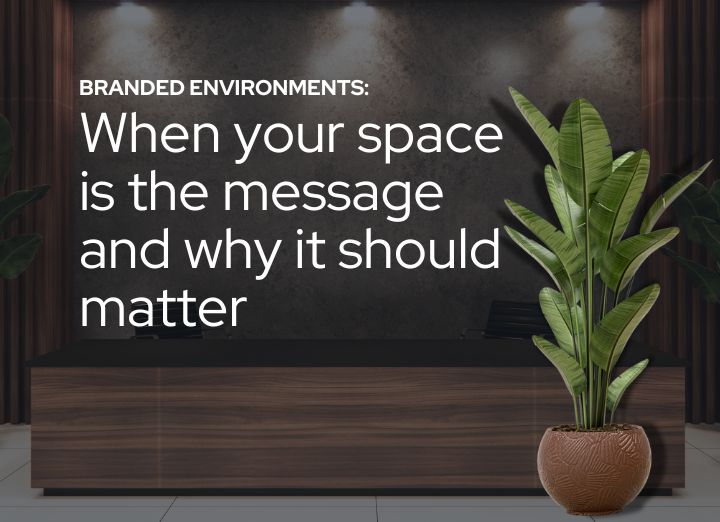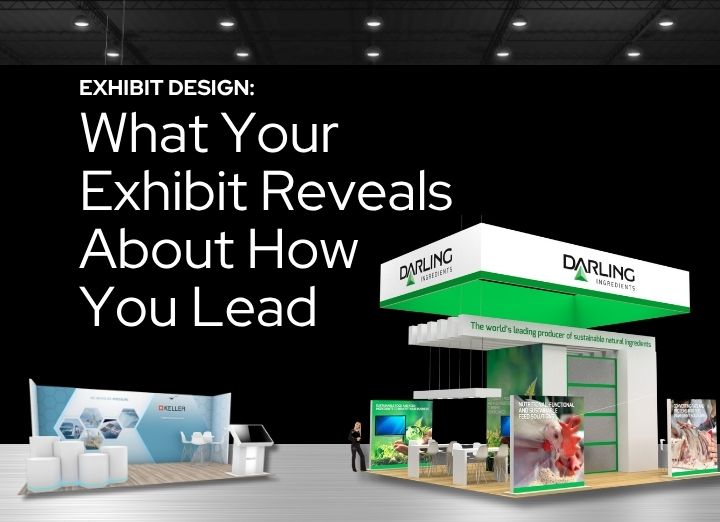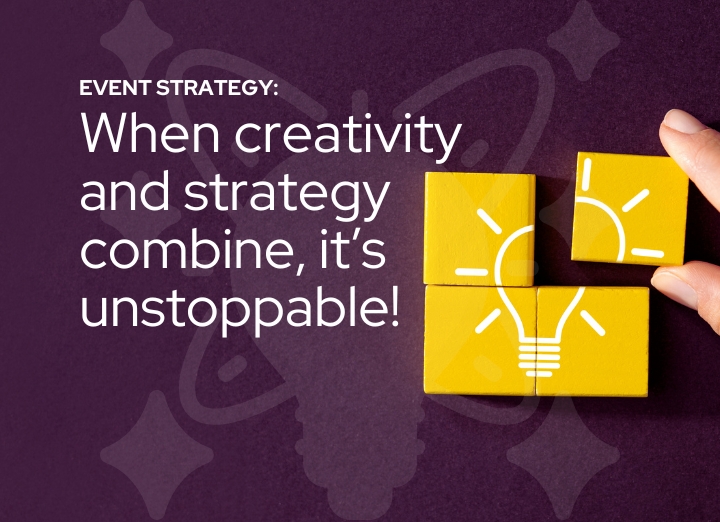You’ve polished your website, refined your brand voice, and invested in marketing that tells your story—online, on paper, and on stage. But what happens when someone walks into your building?
Whether it’s a client, a prospect, a job candidate, or even your own team, your physical space is one of the most powerful brand touchpoints you have. And yet, it’s often the most overlooked.
We’re talking about branded environments and why making your space say what your brand stands for isn’t just smart design. It’s a strategic decision with real business impact.
The unspoken story your space is already telling

Every space tells a story. The question is whether yours is telling the right one.
Walk into a bare, generic lobby with buzzing fluorescents and outdated posters, and you might think: “Do they care about the details?” Step into a space with intentional design, consistent messaging, and a clear sense of identity. You immediately feel like you’re somewhere that knows who they are.
That’s the power of a branded environment. It’s not about making your office “look nice.” It’s about aligning what people see, feel, and experience in your space with what your brand promises out in the world.
The psychology behind physical brand experiences
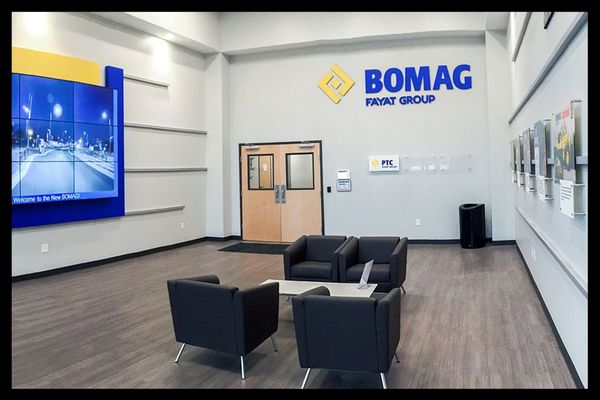
We remember what we experience. Studies show that people are more likely to recall brands they’ve interacted with physically—especially when there’s an emotional connection involved. And your space can tap into that.
From the color of your walls to the signage, lighting, layout, and even the music playing in the background, each detail plays a role in setting the tone. Warm lighting and natural textures can evoke trust. Clean lines and bold graphics may communicate innovation. Interactive displays or digital screens can create engagement and energy.
When these elements work together, they do more than decorate—they communicate. And they give your brand staying power.
Where branded environments make the most impact
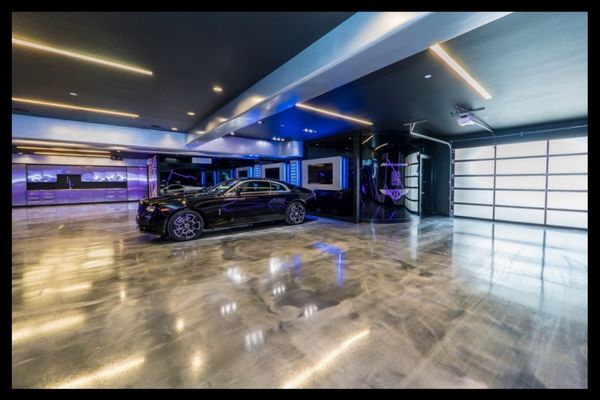
Branded environments aren’t limited to high-profile headquarters. They belong anywhere your brand meets the real world:
- Corporate Offices: Give clients and employees an immersive sense of your values from the moment they walk in.
- Showrooms & Sales Floors: Let your products live in a space that reflects their purpose and quality.
- Regional Branches: Create consistency across locations—even when teams are remote.
- Distribution Centers or Warehouses: Reinforce safety, pride, and culture for staff and partners.
- Healthcare & Educational Facilities: Build trust and comfort with visuals that support your mission.
- Community Centers or Museums: Tell your story to the public through immersive, engaging displays.
The point is: your environment is always communicating. You just get to choose what it says.
Bringing tradition and purpose to life: The SEAL Heritage Center
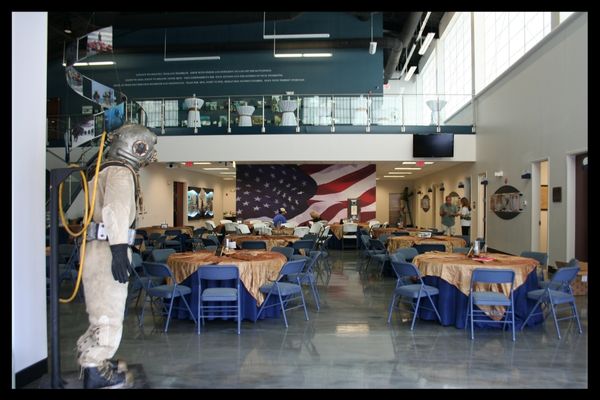
A powerful example of a branded environment in action is the SEAL Heritage Center in Virginia Beach, VA. Apple Rock was honored to partner with the Navy SEAL Foundation to conceptualize, design, fabricate, and install the interior space of this meaningful project.
Located on the Joint Expeditionary Base Little Creek-Fort Story, the SEAL Heritage Center serves as administrative offices for two nonprofit organizations, the Navy SEAL Foundation and the UDT-SEAL Association. More importantly, it’s a gathering space where current and former SEAL Team members, their families, and supporters can meet, reconnect, and honor their shared legacy.
The challenge was balancing two distinct needs: creating a functional, durable office environment while also designing a space that honors the rich history, service, and sacrifice of the SEAL community. The space needed to feel both professional and deeply personal.
Working closely with the building committee, Apple Rock developed a comprehensive visual plan that embraced tradition while supporting the Center’s everyday use. From meeting rooms and common areas to the branded merchandise section, every detail was designed with intention—leveraging colors, logos, fixtures, and lighting to reflect the identity and values of the SEAL Teams.
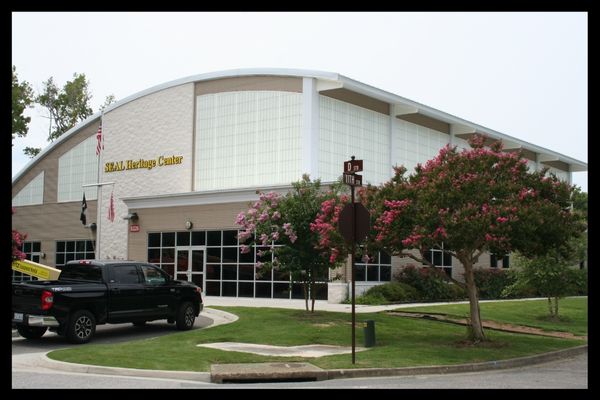

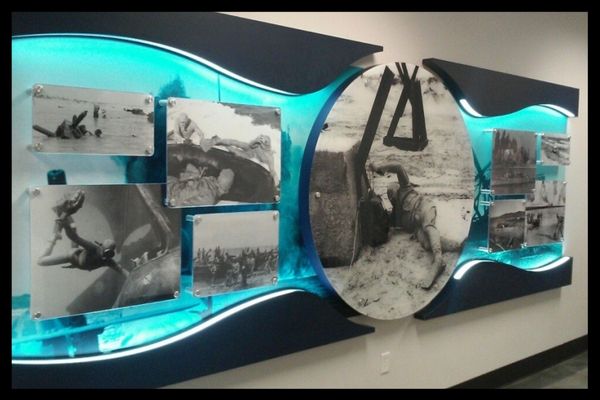
Apple Rock handled every aspect of the project, from design to fabrication, using high-quality materials and expert craftsmanship. The result is a space that not only serves its practical purpose but also tells a powerful story. One that resonates with every visitor who walks through its doors.
This project reflects exactly what a branded environment can achieve: creating a meaningful connection between space, purpose, and the people it’s meant to serve.
Why consistency between marketing and space matters
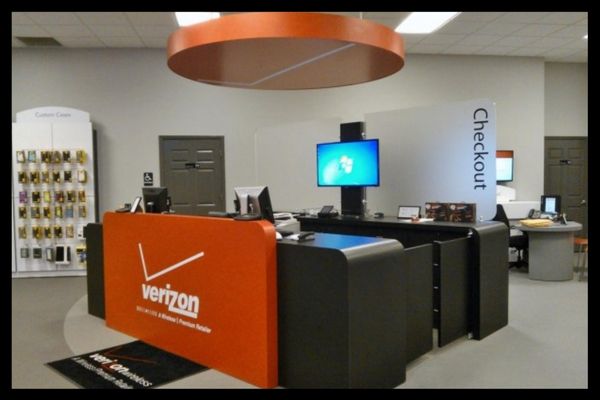
We’ve all seen brands that make big promises on their websites—then underwhelm when you visit in person. Maybe the signage is outdated. Maybe there’s no trace of the visuals that hooked you online. That disconnect can shake confidence.
The most effective brands create a seamless experience from digital to physical. That means when someone lands in your space, it feels like a continuation, not a contradiction, of everything they’ve seen and heard up to that point.
What makes a branded environment work
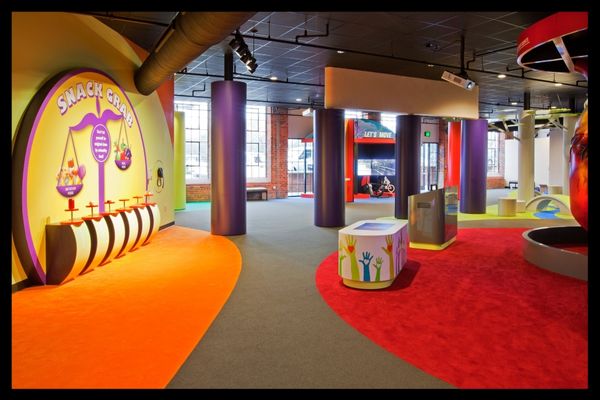
It’s not just about putting a logo on the wall. A well-designed space creates a full sensory experience. Here’s what makes the difference:
- Visual Flow: Clear sightlines, intuitive layout, and design elements that guide the eye naturally.
- Authenticity: Graphics, messaging, and imagery that reflect your real values. Not just marketing buzzwords.
- Material Choice: From textured walls to dynamic lighting and digital displays, the materials you choose affect tone and perception.
- Interactive Touchpoints: Screens, touchscreen displays, or even tactile experiences make visitors feel part of your story.
- Flexibility: Spaces that evolve with your brand and are easy to refresh as messaging or campaigns shift.
Think of it as building a physical extension of your brand identity—one that welcomes, informs, and leaves an impression.
Where to begin building your branded environment
If this all sounds exciting—but also a little overwhelming—you’re not alone. The good news is, you don’t have to overhaul your entire space overnight to make an impact. Start small. Start smart.
Here are a few ways to begin building (or refreshing) a branded environment:
1. Walk Your Space Like a Visitor
Pretend it’s your first time entering the building. What do you notice first? What’s missing? Are there any elements that actively support your brand story or contradict it? This “fresh eyes” walkthrough often reveals easy wins.
2. Identify Your Core Brand Messages
Pick 3–5 brand values or messages you want visitors to remember. These will be your foundation. For example: innovation, reliability, creativity, sustainability. Every design choice should support those messages in some way either visually or emotionally.
3. Prioritize High-Traffic Areas
Focus on the first impression zones: your lobby, waiting area, entryway, showroom or hallway leading to key meeting rooms. These spaces offer the highest visibility and often require the least square footage to make a big difference.
4. Use Temporary Elements to Test Ideas
Wall graphics, branded panels, even digital signage can be updated or moved easily. This allows you to test design concepts, seasonal messaging, or campaigns without a permanent commitment.
5. Partner with the Right Team
A trusted design or fabrication partner can help you translate your brand into physical form and guide you through material choices, installation, and long-term maintenance.
That’s where Apple Rock comes in. From concept to completion, we help translate your brand into physical form, guiding you through layout, materials, messaging, and the finishing touches that make it all work. Whether you’re building from scratch or refreshing a space, we’ll help you get it right the first time—and keep it working for the long haul.
Common pitfalls to avoid
Creating a branded environment doesn’t have to be complicated—but it does require thought. Here are a few traps to sidestep:
- Overbranding: A logo on every wall isn’t strategy. It’s clutter. Balance is key.
- Inconsistent Visuals: Mixing old and new materials can confuse your message.
- Neglecting Updates: Outdated graphics or damaged signage undercut professionalism.
- Ignoring the Audience: A space that doesn’t consider how visitors move, feel, and engage won’t leave the right mark.
Every touchpoint matters. You don’t need to redesign everything at once, but consistency, clarity, and purpose should guide the process.
More than just decoration. It’s a smart business tool.
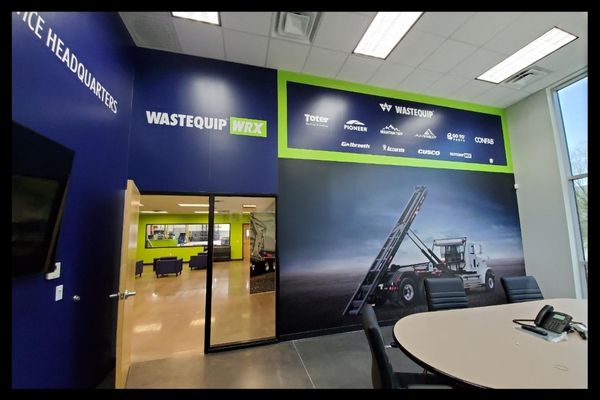
This isn’t just about aesthetics, it’s about brand performance. A well-branded environment:
- Strengthens client trust and loyalty
- Improves employee pride and morale
- Reinforces your brand promise at every touchpoint
- Creates memorable experiences that drive word-of-mouth and referrals
In short, it becomes a living, breathing version of everything you want your brand to be.
What does your space say about you?

If a new client walked into your space right now—what would they take away from it?
Would they feel who you are? Would they see your attention to detail, your values, your vibe? Or would they wonder if they’d walked into the wrong office?
Branded environments offer a rare opportunity to bring your story to life both physically and powerfully. And with today’s digital noise, that kind of real-world brand presence is more valuable than ever.
If your space isn’t telling the right story, let’s change that. Apple Rock can help you design an environment that speaks volumes—without saying a word.
